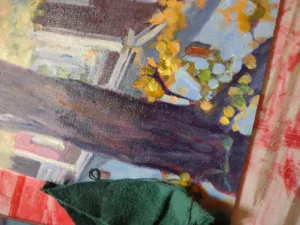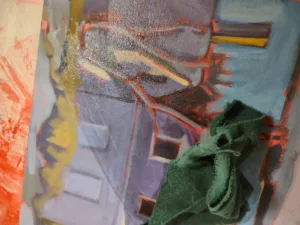
What is sinking paint?
When the top layer of oil paint has been lost to the layer underneath, the surface of the painting can turn grey and lifeless.
The siccative oils in oil paint don’t dry from evaporation; rather they harden in the presence of oxygen. This is the fundamental reason for the fat-over-lean rule. Ignoring it will create other long-term preservation problems besides the ghostly greys settling over your paintings.
Sinking appears slowly over time. A painting that was once boisterously colorful turns dull. The different drying times of pigments means that color will sink unevenly across the canvas, giving it an irregular, blotchy look. Details that were once subtly beautiful will disappear.
That dull film is the pigment granules standing alone, without their enveloping oil. Yes, pigment gives oil paint its color, but without a rich bath of oil to surround it, pigment just looks dull and grey.
In most cases, the entire painting won’t be affected. There will be passages that look dull to the eye sitting next to glossy, normal paint. Sinking is most visible in the dark passages, particularly when they’ve been applied thinly, as most traditional teachers recommend.
Since sinking only appears in dry paint, you will often see it in paintings you’ve set aside for a few weeks or months. You can quickly tell if you have a sinking-in problem by wiping the offending passages with a light layer of odorless mineral spirits (OMS). If color comes back, it was sunk. Don’t try this on a recently-painted work; the solvent can dislodge not-quite-cured paint.
By the way, underpainting should sink if you leave it unfinished-it’s part of the fat-over-lean rule that you don’t use oils in this layer.

How to prevent sinking-in
Sinking has three common causes:
Too much solvent-the painter has not mastered the art of using unadulterated paint or painting mediums in the top layer. He relies too much on solvent instead of mediums to get good flow. The OMS takes the place of the linseed oil binder and then evaporates. That leaves the pigment particles isolated, with no oil surround. Air doesn’t have the same refractive index as linseed oil, so pigments that look dark and beautiful in solution looks dull and grey when the binder disappears.
Not enough oil in the top layer of paint-there’s enough oil in modern paints to make a solid top layer, but only if applied in proper thickness. If you want to paint thin, you must cut your paint with an oil-based medium, not with OMS.
Over-absorbent grounds-acrylic gesso is more absorbent than oil gesso, but a well-prepared acrylic ground is fine. However, a very inexpensive board may not have enough ground to stop oil from seeping through. An aftermarket coating of gesso is a good cure. Non-traditional grounds like paper and raw fabric need very careful preparation.
What to do about sinking
Sinking is a case of an ounce of prevention being worth a pound of cure, but it is fixable.
Sometimes, you can see that a passage is sinking while you’re still working on the painting. If this has happened in a bottom layer, ignore it-that’s how it’s supposed to work. If the passage is finished, oiling-out is your best option. Simply brush a very thin layer of medium across the surface in the areas that have turned grey. Then remove the excess with a lint-free painting cloth. You can paint straight onto this slightly tacky surface, or wait for it to dry.
If you find sinking in a thoroughly-dry painting, varnish is your best option. Unlike oiling-out, varnish creates an entirely-separate layer that won’t give future conservators fits.
Reserve your spot now for a workshop in 2025:
- Advanced Plein Air Painting, Rockport, ME, July 7-11, 2025.
- Sea and Sky at Acadia National Park, August 3-8, 2025.
- Find Your Authentic Voice in Plein Air, Berkshires, MA, August 11-15, 2025.
- Immersive In-Person Fall Workshop, Rockport, ME, October 6-10, 2025.



